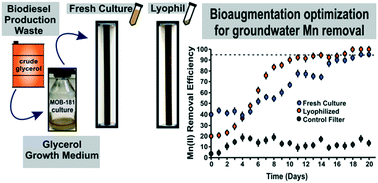Optimization of bacterial bioaugmentation for groundwater Mn removal using a waste-based culture medium and lyophilization
Abstract
Biological sand filtration systems are widely used for groundwater Mn removal. Bioaugmentation of sand filters through inoculation with Mn(II)-oxidizing bacteria (MOB) have contributed to the optimization of this biofiltration. However, a challenging aspect of this bioaugmentation process on a large scale is keeping fresh MOB cultures viable and transporting large culture volumes to groundwater treatment plants. In this work, powdered MOB inoculums were prepared by vacuum lyophilization. Bacterial lyophilization was performed in different growth conditions and the best performance was observed in biofilms covered with biogenic Mn oxides. On the other hand, a culture medium to produce the inoculum was developed using crude glycerol waste. Inoculums grown and lyophilized in this glycerol medium were able to be immobilized onto sand filters and to enhance the performance of groundwater Mn removal, reaching the optimal removal efficiency faster than fresh MOB cultures. These results generate new tools to simultaneously, re-use crude glycerol waste and improve large scale bioaugmentation approaches for groundwater Mn removal.

- This article is part of the themed collection: Urgent communications in RSC Environmental Science journals


 Please wait while we load your content...
Please wait while we load your content...